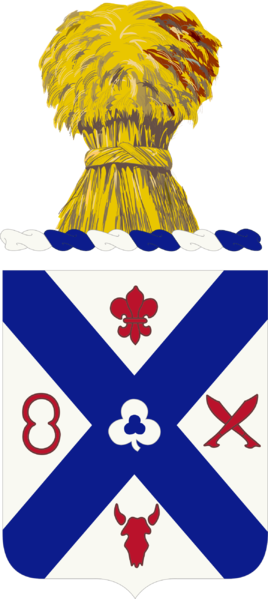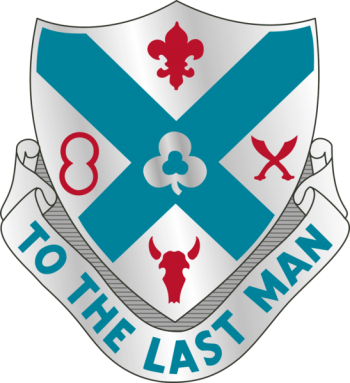135th Infantry Regiment, Minnesota Army National Guard
135TH INFANTRY REGIMENT, MINNESOTA ARMY NATIONAL GUARD
| (Coat of Arms) |
(Distinctive Unit Insignia) |
Official blazon
Shield: Argent, on a saltire Azure between in chief a fleur-de-lis Gules, in fess the Corps badge of the 2nd Division, 8th Army Corps during the Spanish War Proper (two White circles overlapping each other one-third radius, resembling the figure “8”) fringed of the third and two bolos saltirewise and in base a bull’s skull of the like, the 2nd Division, 2nd Corps badge of the Civil War of the fourth (a White three-leaf clover with stem, voided).
Crest: That for regiments and separate battalions of the Minnesota Army National Guard: From a wreath Argent and Azure, a sheaf of wheat Proper.
Motto: To the last man.
Distinctive Unit Insignia, Description: A Silver color metal and enamel device 1⅛ inches (2.86 cm) in height overall consisting of a shield blazoned: Argent, on a saltire Azure between in chief a fleur-de-lis Gules, in fess the Corps badge of the 2nd Division, 8th Army Corps during the Spanish War Proper (two Silver circles overlapping each other one-third radius, resembling the figure “8”) fringed of the third and two bolos saltirewise and in base a bull’s skull of the like, the 2nd Division, 2nd Corps badge of the Civil War of the fourth (a Silver three-leaf clover with stem, voided). Attached below and to the sides of the shield a Silver scroll inscribed “TO THE LAST MAN” in Blue letters.
Origin/meaning
The shield is white (silver), the old Infantry colors. The blue saltire is taken from the Confederate flag - for Civil War service. At the battle of Gettysburg the 1st Minnesota Infantry Volunteers were in the 2nd Division, 2nd Corps (Hancock’s), whose badge was the three-leaf clover. The figure “8” represents the Spanish War service and the crossed bolos the Philippine Insurrection service, while the fleur-de-lis represents World War I service of the 135th Infantry. The bull’s skull (shoulder sleeve insignia of the 34th Division) indicates service with this Division during the period of peace and through World War II.
The arms were approved on 23 June 1926, and the Distictive Unit Insignia on 18 June 1926. They was amended to show additional War Service on 19 December 1951. Literature: Image from Wikimedia Commons.

